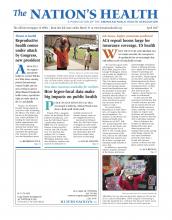More restrictive alcohol policies help prevent drunken driving deaths among young people, a new study finds.
The stronger a state’s alcohol policies, the less likely it is that young people will die in alcohol-related motor vehicle crashes, with a decrease in alcohol consumption across the board, according to a study published in February’s Pediatrics.
“Our results suggest that more alcohol policies acting in concert protect the health and well-being of young people,” lead study author Scott Hadland, MD, MPH, MS, assistant professor of pediatrics at the Boston University School of Medicine, told The Nation’s Health. “We in the public health community should advocate for stronger and more comprehensive alcohol policies in our cities and states, and recognize that there is not a single ‘magic bullet’ policy — that it really is the collection of policies that keep the public safe.”
Researchers used the Alcohol Policy Scale, an assessment of 29 alcohol policies throughout the 50 states and Washington, D.C., using data from 1992 to 2012. A group of policy experts worked with study investigators to determine the efficacy of each law, as well as what made it broadly applicable and enforceable. The laws were scored on a scale from 0 to 100, with higher scores correlating with more restrictive alcohol policies. Examples of alcohol policy provisions include “laws relating to alcohol taxes, and laws limiting the hours, location and overall availability of alcohol,” Hadland said.
Researchers extracted data on fatal motor vehicle crashes from 2000 to 2013 from the Fatality Analysis Reporting System database of the National Highway Traffic Safety Administration, focusing on people ages 20 and younger.
They found that a 10 percentage point increase in states’ alcohol policies correlated with a 9 percent decrease in the likelihood of alcohol-related deaths from motor vehicle crashes. States with the highest Alcohol Policy Scale scores were Alabama, Delaware, Illinois, Kansas, New Hampshire, Oklahoma, Pennsylvania, Tennessee and Washington.
Underage drivers in motor vehicle crashes were more likely to be male, 18 to 20 years old and white. Passengers who died were more likely to be female, 16 to 17 years old and white.
State alcohol policies had a similar impact across sex and age groups, as well as among drivers and passengers. However, the impact was not the same for Hispanic and black young people. Previous studies show that black and Hispanic people are less likely to be in alcohol-related motor vehicle crashes, but seat belt and child restraint policies may reach fewer people in such populations, according to the researchers.
They said it was important to consider all policies that impact the availability and consumption of alcohol to promote safer outcomes.
“In general, alcohol policies that are effective at reducing motor vehicle crash deaths among young people aren’t necessarily those that target drinking and driving among teens and young adults,” Hadland said. “In fact, policies that limit drinking in the overall population and that aren’t necessarily targeted specifically at youth are effective.”
For more information, visit http://pediatrics.aappublications.org/content/early/2017/02/09/peds.2016-3037.
- Copyright The Nation’s Health, American Public Health Association









